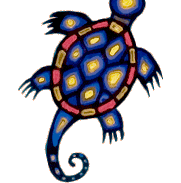Dialogues avec un sauvage : perspectives contemporaines
GRANDE BIBLIOTHÈQUE - ARTS AND LITERATURE SECTION, LEVEL 1 - JUNE 10 TO OCTOBER
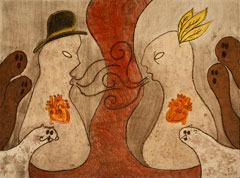
JASMIN GUNN et ROGER NELSON
LES ESPRITS PARLENT
monotype, 75 x 54,5 cm, 2008
This exhibition features creations by eight First Nations artists involved in very different fields of experimentation. They were invited to draw upon the work by Lahontan (1666-1715) Dialogues de M. le baron de Lahontan et d’un Sauvage dans l’Amérique to explore the theme of dialogue and encounter with the Other.
Some of the artists opted to use Lahontan’s text as a springboard for their creation, others drew upon the dialogue situation to focus on questions of identity, belonging or cultural mixing, by means of their artistic process.
These dialogues, published in 1703, were both satirical and polemical. They praised primitive life and criticized the European society of the times, giving the Amerindian character Adario a leading role in the narrative. The words exchanged by Lahontan and his Huron Chief character are the prototype of Rousseau’s creation a few decades later of the figure of the ìnoble savageî, a myth that would long resonate with certain European aficionados of virgin forests.
These days, we might be more inclined to smile at references to this fictional work that contributed to the great ferment of ideas known as the Enlightenment. What renewed vision could be drawn from these Dialogues, shedding a different light on our current relations with Amerindian societies?
A free spirit permeates the works, which also have humorous touches. We are taken on a journey to explore past and present worlds. These are brought to life via imaginative tales and descriptions of the most mundane aspects of daily life. These works provide us an opportunity to discover First Nations art from novel perspectives.
Between spirituality and material culture, between dream and memory, between encounter and silence, eight artists guide us on a road that leads back to our current location, and from there, leads us to the other.
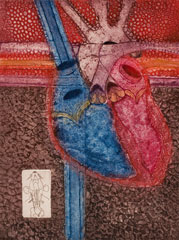
JASMIN GUNN
DEAD HEART BEAT
collagraphy and etching,
38 x 56 cm, 2008
Trained at Centre de l'image et de l'estampe de Mirabel (CIEM), Jasmin Gunn et Roger Nelson from Kanesatake found rewarding creative approaches from the very start. Roger Nelson opted for a very free exploration of the iconography of petroglyphs, while Jasmin Gunn provides a touching and at times wrenching portrait of her own life around the specific shape of the human heart.
Les esprits parlent, a joint work by Gunn and Nelson, is in itself a dialogue with all the lightness of friendly banter. The work conveys a sense of humour that appears in the treatment of textures, shapes and colours as in the somewhat ironic representation of the European with his ridiculous tiny hat and the Savage with his stereotyped feathers. We understand the mischievousness of the spirits who are scampering about all around. The fresh approach of this ensemble provides a remove from simple face and if we look closer, we see that the two characters speak from the same heart.
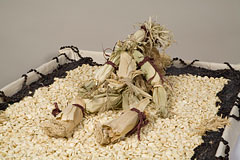
SYLVIE-ANNE SIOUI TRUDEL
DERNIER DISCOURS D’ADARIO
mixed media,71 x 147 cm, 2008 (detail)
Of Wendat origin, Sylvie-Anne Sioui Trudel founded the company Aataentsic Masques et Théâtre. Her dramaturgy, which makes extensive use of masks and marionettes, has a distinctive body language, combining elements of traditional Iroquois dances, mime and Japanese theatre.
Le dernier discours d'Adario (Adario's last speech) portrays the last words of the great Kondiaronk, known as The Rat, and named Adario in Lahontan's Dialogues. Theatrically stretched out on his corn-kernel bed, the character, surrounded by masks, makes a speech tinged with wisdom and peace despite his suspicions of the real motivations of the French. Although Adario is represented alone, the work focuses on the very heart of the encounter. The purple and white colours of the work recall those of the peace wampum, symbolizing two main roads, two nations living side-by-side and respecting each other's values.
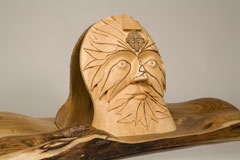
DENIS CHARRETTE
RIVIÈRE MÉTISSE
wood and copper, 51x135x42 cm,
2008 (detail)
Denis Charette, an Algonquin Métis living in the Outaouais region, sees sculpture as a spiritual mission – the artist's receptiveness towards his medium leads to revelation. A recent Canada Arts Council grant recipient, he continues to delve deeper into his study of the culture and spirituality of the Algonquian peoples.
Denis Charette sees himself as a descendant of Lahontan and Adario. He navigates on La rivière métisse and imagines a bridge spanning it uniting the White Man and the Red Man. The river carries the great dream of union in its current. Although the two masks turn their backs to one another, the work remains a call for an authentic reconciliation. These two masks make up the visage of the biracial man, carrying his memory of blood and light.
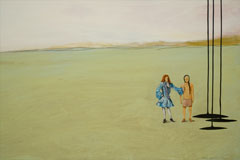
RAPHAËL BENEDICT
MODIFICATION DU BEAU
acrylic, ink and pencil on canvas
213 x 160 cm, 2008
A Bachelor of Visual Arts from l'Université du Québec à Trois-Rivières, Abenaki Raphael Benedict creates work with a poetic impact based on an urgent quest for identity, leading him to a stronger identification with his original culture.
What does Raphaël Benedict show us in La modification du beau? Lost in a vast landscape, clear-cut forest, lawn or desert, under a sky that long coulees of ink prevent from dissolving, two characters, the Frenchman and the Savage, mimic the pose of the famous painting titled Portrait présumé de Gabrielle d'Estrée et de sa soeur la duchesse de Villars, an anonymous work painted around 1594. This iconographic reference to French painting bears no relation to traditional Aboriginal imagery, but the work tackles above all the question of territory, be it real or symbolic. Here, the figures play a smaller role than the plastic elements of the painting; surfaces and textures, colours and forms, in creating a real space for dialogue.
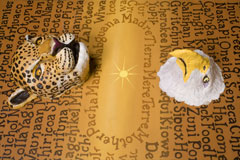
OSWALDO DELEON KANTULE
LA RENCONTRE DU JAGUAR ET DE L'AIGLE
mixed media, 51x76 cm, 2008
Born on Panama's Ustupu Island, in the Kuna Nation, OSWALDO DELEON KANTULE is developing a protean body of work in which painting, drawing, printmaking, sculpture, installation and performance join forces on the threshold of a dream territory peopled by spiritual beings, animals and fantastic birds.
In his painting Hommage à Norval Morrisseau, Oswaldo DeLeon Kantule unites the Aboriginal mythologies of North and South. Two traditions meet and enrich each other. Kantule's bright colours are evocative of a free, mad dance in which the Ojibway Morrisseau's Shamanic universe is visited by spirits from the Kuna culture that nourishes Kantule's own work. In his bas-relief entitled La rencontre du jaguar et de l'aigle, he returns to this North- South dialogue by tracing the names of each nation that used to inhabit the Americas, from Baffin Island to the Tierra del Fuego.
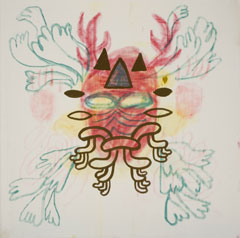
WALTER KAHERO:TON SCOTT
PSYCHIC TRIBE
monotype and ink, 107 x 107 cm, 2008
(detail 1 of 9)
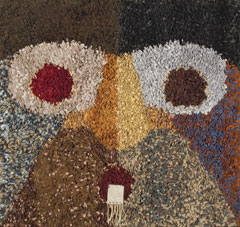
SYLVAIN RIVARD
DIALOGUE AVEC UN SAUVAGE
leather, metal, beads and thread,
89 x 89 cm, 2008
(detail)
WALTER KAHERO:TON SCOTT, a Mohawk from Kahnawake, with a diploma in film and communications from Dawson College, is now studying visual arts and anthropology at Concordia university. Every week in the Kahnawake newspaper The Eastern Door, he pens the comic strip Little Feather. His characters worry about their future, a recurrent theme in his work.
Walter Kahero:ton Scott's Psychic Tribe series of engravings is a visual discussion between beings seeking what defines them as a “tribe” through a shared symbolism. These beings or spirits, which have symbolic attributes to varying extents, make up a community. A lexicon of body language, forms and signs come out of the ensemble, setting the foundation of these spirits' specific language. Each of the nine engravings making up this work retains its own identity, but all of them call upon each other and answer in a neverending suite of fragmented words.
Par sa formation en théâtre, en danse et en chant, Sylvain Rivard, coauteur de Archéologie sonore Chants amérindiens, est activement engagé dans la diffusion des multiples aspects de la culture des Premières Nations. Son désir constant de rester fidèle à ce qu’il veut faire connaître en fait un animateur important auprès des écoles, des musées, des éditeurs et des producteurs de films ou de séries télévisées.
Dialogue avec un Sauvage est un large visage de lanières de cuir nouées crachant un wampum fait de perles enfilées et tissées; ce visage est flanqué de deux œuvres, Cultures matérielles et L’agneau et le castor, qui agissent ici comme parties spécifiques du discours. Cultures matérielles montre un éventail des matériaux et des techniques utilisées par les Premières Nations, alors que L’agneau et le castor illustre les effets de la rencontre entre l’Européen et le Sauvage. La clé de ce triptyque se trouve peut-être dans le wampum, qui signifie métaphoriquement paroles, mots ou voix.
Une exposition réalisée par Bibliothèque et Archives nationales du Québec et Terres en vues à l’occasion du festival Présence autochtone.
Photos par Richard-Max Tremblay
Prints and Sculptures
MAY 30 TO JUNE 28 - CANADIAN GUILD OF CRAFTS
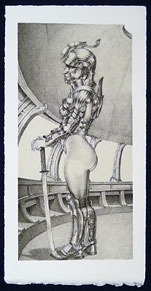
Kevin Proulx
Sheera
2007
Five Mohawk artists from Kanesatake are showing creative works enriched by the process of learning new techniques. Seeking accurate expressions of their reality has led them to explore printmaking and its contemporary arts applications, in a spirit of great freedom. Each printmaker has made use of the elements he or she needs to create strong, original works. Their variety confirms thirst for knowledge motivating these artists.
In turn Jasmin Gunn, Roger Nelson, Graig Nicholas, Audrey Avery and Kevin Proulx have what it takes to surprise us, touch us, turn clichés on their heads and sometimes provide us a hint of an ironic smile.*
Algonquin Métis sculptor Denis Charette's body of work calls upon several legends from those who have walked before us on the sacred earth. For this artist, matter is a living thing. His sculptures speak of the wind, water, earth, fire, men, animals and stones – all of these caught up in a whirlwind reminding us that we are all related by the same essence.
An exhibition proposed by Suzie Pilon du Centre de l’Image et de l’Estampe de Mirabel (CIEM).
Located in the Sainte-Scolastique sector of Mirabel, CIEM aims to develop research, production and promotion/marketing of contem?porary graphic work. The CIEM workshop is equipped with quality equipment and a highly qualified training staff, providing a place to explore the major printmaking techniques.
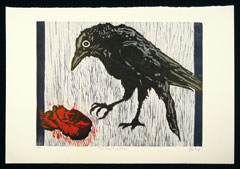
JASMIN GUNN
THE ELEMENT OF MURDER
2007
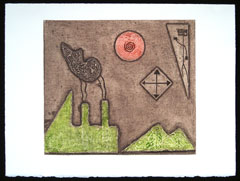
Roger Nelson
CONTRAST
2007
Events at maison de la culture Notre-Dame-de-Grâce
3755 Botrel St., Montréal (metro Villa-maria) Information : 514.872.2157, ville.montreal.qc.ca/accesculture
Serge Gosselin, Capteur de rêve
FROM MAY 8 TO JUNE 22 from 1p.m.
Photography of Peruvian First Peoples and Anicinapeks from Kitcisakik in La Vérendrye Park, catching dreams.
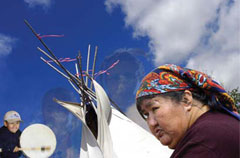
Serge Gosselin
LE CERCLE DE VIE
2004,
Christine Sioui Wawanoloath, L’Île de la tortue
FROM MAY 8 TO JUNE 22 from 1p.m
Video animation on Skywoman's creation of the Wendat world. Works on paper and sculptures by the artist will also be on exhibit.
Mon bestiaire songs and tales by Sylvain Rivard (VainVard)
THURSDAY JUNE 12 at 8p.m
Répertoire de contes métissés et de musique folkloriques peuplés d’êtres fabuleux.
Creation of the world as imagined by the Huron-Wendat nation (youth audience)
SUNDAY JUNE 22 at 3p.m.
Two actors/storytellers recount the creation of the world as imagined by the Huron-Wendat nation. Production: La compagnie de théâtre Les Deux Mondes.

